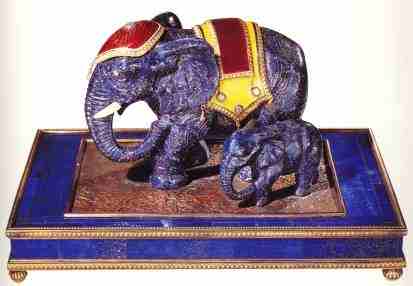 |
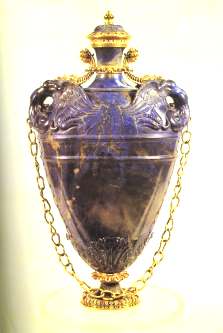 |
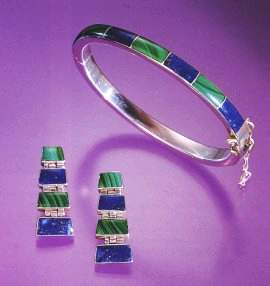 |
|
ファベルジェ工房製のラピスラズリの置物 幅16cm |
金の鎖付き酒瓶 40.5cm |
チリ産ラピスラズリと孔雀石の装飾品 |
ラピスラズリ(lapis-lazuli)
2. 世界のラピスラズリ産地
(World locality)
 |
 |
 |
|
ファベルジェ工房製のラピスラズリの置物 幅16cm |
金の鎖付き酒瓶 40.5cm |
チリ産ラピスラズリと孔雀石の装飾品 |
数千年の昔から工芸品などに使われていたラピスラズリですが、かつてはその全てがアフガニスタンの山奥で採掘され、オリエントやヨーロッパ、さらにインド、中国、日本へと運ばれて珍重されたものでした。
アフガニスタンが最も高品質のラピスラズリの産地であることに変わりはありませんが険しい山岳地帯での採掘のために産出と輸送量には限界があり、供給量は限られています。
代わって今日ではチリの鉱山から年間150トンと大量の供給があります。
この他にシベリアのバイカル湖地方、アメリカのコロラド州やカリフォルニア等にも産地がありますが、量は少なく市場で見かけることは稀です。
冒頭の写真はこうした代表的な産地のラピスラズリを使用した工芸品の例です。
フィレンツェのピッティ宮殿内のアルジェンティ美術館はかつてのメディチ家の宝物庫でした。黄金の装飾で飾られた酒瓶は金色の黄鉄鉱が煌くラピスラズリ製ですがこんなに大きく極上のラピスラズリは今日でさえも入手するのは困難です。
当時のメディチ家の威光を思い知らされます。
酒瓶はミケランジェロの優れた弟子でありヴァザーリと共にウフィツィ宮殿を完成させた建築家、彫刻家、画家の Buontalentiがフランドル出身の金工師 Bilibertiと共に1583年に製作したものです。
ファベルジェの作品同様、ラピスラズリは時代の超一流の作家しか扱うことの出来ない貴重な素材でありました。
Lapis-lazuli is one of the first gem materials used for adornment as an ornamental stone since more than 6000 years in Middle East, Asia and Europe. Most of the material used by these ancient civilizations is believed to have originated from the Sar-e-Sang deposits in present-day Badakhshan, Afghanistan, which is yet a unique locality to supply the best quality lapis-lazuli in the world.
However, the supply is limited to low level due to the mining condition in the remote harsh mountain.
Instead, a relatively new commer, mines of Chile supply as much as 150 tons of lapis-lazuli annualy.
Lapis-lazuli is discovered in the Lake Baikal area of Siberia, Colorado and California of U.S.A., but the supply is sporadic and we rarely have an opportunity see them in the market.
Photos on top are examples of the lapis-lazuli works to represent important localities. Wine base with gold chain was haoused in Algenti Museum(Once a treasury of Medici Family in the Italian Renaissance) and is a masterpiece made by Buontalenti and Biliberti in 1583.
ラピスラズリの産状(Formation and Occurence of Lapis-lazuli)
鉱物の本には石灰岩の接触変成地帯に産するとあります。確かにそのとおりではありますが、しかしそれでは全く不十分な説明です。
石灰岩の接触変成地帯は世界に無数に存在しますが、ラピスラズリの産地は数えるほどしかありません。
したがってラピスラズリの生成には更に特殊な要因を考えなければなりません。
そして世界に数少ない産地;アフガニスタンのヒンドゥークシュ山脈からパミール山脈一帯、ビルマのモゴク、シベリアのバイカル湖近辺、北米のロッキー山脈周辺、そしてチリのアンデス山脈という地理を眺め渡すと、いずれも5000万年から3000万年前に起こった地球規模の造山運動により海底が盛り上がって大山脈が形成されたり、巨大な断層湖が生成されたという共通の背景があります。
唯一の例外はイタリアのヴェスヴィオ火山産のラピスラズリでこちらは火山活動というごく小規模な地殻活動によるものです。
即ち地球規模の地殻変動によってもたらされた石灰岩の広域接触変成地帯中のほんの一部に稀に生成されたのがラピスラズリであるといえます。
Books and encyclopedias mention lapis-lazuli as contact metamorphosed mineral in limestone, simply.
It is true but not sufficient, at all. Because there are millions of contact metamorphic zones of limestone in the world, but the lapis-lazuli occurences are quite limited to less than 10 localities.
It is, therefoe necessary to consider some particular factor on lapis-lazuli formation.
Then, when world occurences are studied carefully, we come to the conclusion that tha all localities share the common condition ; Hindu-Kush to Pamir Mtns., Mogok, Burma, The Lake of Bikal are of Siberia, Rocky Mtn in North America and Chile of Andes Mtns., they are in the same area where the earth scale diastrophism occured about 30 to 50 million years ago. Only one exception is a lapis-lazuli formed by volcanic activity of Mt. Vesuvio Italia.
Lapis-lazuli is a rare contact metamorphic mineral rarely formed as the result of earth scale diastrophism.
アフガニスタンのラピスラズリ(Afghan Lapis-lazuli)
サーレサン鉱山の光景 写真右下はズリ
The small valley of Sar-e-Sang.
White rocks at the base of photograph
are the mine dumpサーレサン鉱山の地図
Map to Sar-e-Sangサーレサンに至るコクチャ渓谷
Route through the Kokcha valley
25 miles before Sar-e-Sang
鉱山があるコクチャ渓谷の衛星写真
Satellite photo of Kokcha River Valley
with lapis mines marked by red dots大理石層(青)に沿って南北
16kmに8ヶ所の鉱山がある
Geology and mine locations
along the Kokcha Riverサーレサンの垂直の大理石の壁に穿かれた巨大な坑道入り口
Vertical series of mine entrances in the Sar-e-Sang area
サーレサンへの道程(The sight to Sar-e-Sang)
サーレサン鉱山は周囲を5000m級のヒンドゥークシュ山脈に囲まれた、アムダリア河の支流コクチャ渓谷の右岸、標高2500mの地点に位置します。首都カブールからは二つのルートがあり、短い方はチャリカール経由でパンジシール渓谷の途中ダシット・ラワットまでの160kmをジープで行き、残り標高4250mのアンジュマン峠を越えての135kmを徒歩または馬で計4日間のルートです。
長い方はカブールから標高3700mのサラン峠を北上しコンドゥズを経てからコクチャ渓谷沿いに迂回しハナバード、タロカン、フェイザバード等の町や村を経て最後の村ジャルムの南100kmまでの750kmを車で行き、さらに最後の40kmを馬かロバで上るルートでこれもたっぷり4日間はかかりますが大半を快適な車の旅で過ごせます。
さらにタクラマカン砂漠からワハン回廊を経て東からジャルムに入る古代からのルートや、徒歩でヒンドゥークシュ山脈を越えてパキスタンのペシャワールへ至るルートもあります。
ともあれ6000年来、この不便な道を辿って何千トンものラピスラズリが遠くオリエントやエジプト、ヨーロッパ、さらにインド、中国、日本へと運ばれました。
この交通事情は今後も改善されることはないでしょう。
因みに鉱山への通行は雪のない6月から11月までの5ヶ月間のみ可能です。
Sar-e-Sang is located in Badkhshan, in the north-east of Afghanistan. It lies in the center of the Hindu-Kush massif, along the right bank of the Kokcha River, which cuts from north to south and anticline with summits reaching 3500m to 5500m.
This region was mentioned in Chinese writings as early as the sixth century. From the village of Jarm, situated about 150km north of the mines, a commercial route following the corridor of Wakhan leads to Tibet and China. During Soviet invasion, almost all lapis-lazuli were brough to Pakistan over Hindu-Kush Mtns on foot.
Two routes connect Kabul to Sar-e-Sang. The shortest route, from the point of view of distance, is to travel by jeep from Charikar, up the valley of the Pnajchir, to Dasht-i-Rawat(around 160km), and the to go the final 135km to the mine on foot or byn horse via Anjuman Pass. Currently, the fastest route, which still takes at least four days, begins with a magnificent drive to Qonduz through Salang Pass. From the city, the traveler must follow a difficult road through Khanabad, Taloqan, Feyzabad, and Jarm that terminates 3 or 4km beyond the village of Hazrat-Said, a distance of about 750km from Kabul. A long journey with horses or donkeys, is then required to climb the 40km of narrow and rough trail that follows the gorges of the Kokcha.
These routes are accessible only between June and November.
ラピスラズリの産状と地質図
Geologic features of the lazurite bearing
zone with lazurite bodies in marble belt大理石中のラピスラズリ団塊
Lapis blocks in a marble数千年間に及ぶ採掘で彫られた広大なトンネルと採掘と搬出の様子
Lapis miners working undergroung in a Sar-e-Sang area
鉱床と採掘(Description of the deposits)
鉱山のキャンプは標高2500mの地にありますが、鉱床はさらに高い2700mから3400mの殆ど垂直な斜面にあります。
採掘機材や爆薬を背負ってよじ登り、帰りにはさらに重い鉱石が加わるという過酷な採掘条件です。
サーレサン複合体と呼ばれる鉱床は片麻岩、大理石、スカルン、結晶片岩、角閃石片岩、淡色化花崗岩脈、角閃岩脈、輝石脈等からなる激しい変成作用を受けた岩盤中にあります。
片麻岩を覆う400mの厚さの大理石の層中にスカルン鉱床を成す40mの幅の灰色の層があり、その中にラピスラズリが生成しています。
ラピスラズリは一般に1〜2m、時に4mに達する厚さのレンズ状の層を成し長さは20m〜100m、稀に400mに及ぶこともあります。
鉱脈は橄欖石、透輝石、柱石、金雲母を伴う石灰岩や苦灰岩からなり青金石には常に黄鉄鉱が含まれています。
レンズ状の鉱脈の中心部には大粒の斜長石、透輝石、方解石と青金石とが含まれ、その周囲を細粒の青金石、透輝石と柱石の層が包み、さらに最外周部が方解石と透輝石、橄欖石と黄鉄鉱の層が覆っているという構造は、堆積層が変成作用を受けたという成因を裏付けるものです。
母岩からの採掘はかつては火を燃やして岩盤を熱し、水をかけて冷却して出来た亀裂から鉱脈を剥がす方法でした。
ダーレーズの古い坑道の天井が黒くこげているのはかつての採掘法の名残です。
現在ではダイナマイトによる採掘が主流ですが、いずれにせよ発破のために標高3000mの垂直な斜面で無数の穴を穿つ困難極まる作業は必要です。
母岩から掘り出されたラピスラズリで100kgを超える大きな塊は稀ですが、均一な組成の10kg程の大きさの塊は普通に得られます。
大理石の多い白色の部分はずっと300m下の谷底へと投げ捨てられていましたが、時に5cmにもなる結晶がこうして捨てられた部分に含まれています。
近年結晶が数多く見られるようになったのは、コレクター用に結晶が注意深く回収されるようになったためでしょう。
The camp is located on the right bank of the Kokcha River at an altitude of 2500m. The mine workings, situated between 2700m and 3400m along nearly vertical in slope, are difficult to reach. The mined blocks of lapis-lazuli are brought back to the camp on the backs of men.
The Sar-e-Sang complex consists of strongly metamorphosed rocks, with gneisses, cipolins(marble), skarns, crystalline schists, amphibolites, and dykes of pyroxenite and hornblendite. The mountain is composed of cipolines up to 400m thick overlying gneiss. Standing out from the white marbles of the cipolines is a gray band, about 40m wide, consisting of skarns in which the lapis-lazuli occurs. The skarns from beds and lenses, generally 1-to-2m - and occasionally 4m - thick, which usually extend laterally for 20 to 100m, rarely more than 400m. The exploitable zones consist of calcite and dolomite associated with forsterite, diopside, and scapolite, often accompanied by phlogopite, sometimes in well-formed crystalsup to 2cm. The blue lazurite is almost always associated with pyrite.
The zonal structure of the most important lenses recalls their sedimentary origins and the action of metamorphism, because the centers of the larger grains consist of a composite of plagioclase, diopside, calcitem and lazurite, which is surrounded by zones of fine, dark blue grains of lazurite, diopside, and scapolite, with a marginal zone of calcite, diopside, foresterite, and pyrite.
In the past, hard rock was fractured with great wood fires, which is today replaced with dynamite.
The lenses of lapis-lazuli detached from the rock are masses of many kiligrams, although they rarely exceed 100kg. Those less than 10kg are relatively homogeneous. The block of rock lacking color are thrown to the dump 300m below. It is in such pieces of cipolin that one must look for well-crystalized lazurite, which today are carefully collected, resulting abundant supply for mineral collectors.
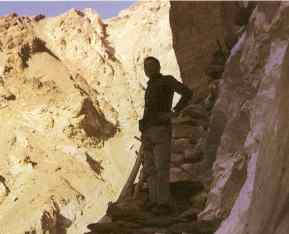 |
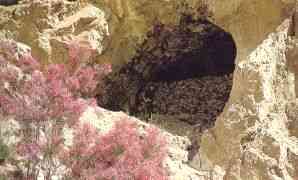 |
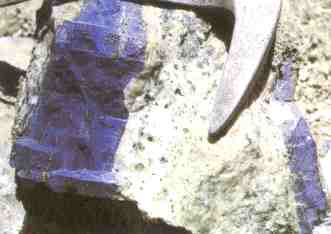 |
|
サーレサンの鉱山への道 |
サーレサンに近いダレーズー鉱山跡 |
ズリ山から採集されたラピスラズリ |
産出量について (Commercial exploitation )
古い資料ですが1981年の Gems & Gemology 誌はソ連軍侵略前の年の平均年間産出量は1トンとしています。
1m立方の大きさのラピスラズリがおよそ3トンほどですから、1トンのラピスラズリの体積は1x1x0.35m程の大きさに過ぎません。
如何に年間に3〜4ヶ月の期間しか採掘できないとは言え、1トンとは少なすぎるように思えます。
おそらくこれは全体の2%に過ぎない宝石質の大きな塊と、同じ質ながら14%を占める大きさが5cm以下ののラピスラズリのみを対象にした産出量かと思われます。
その他普及品の装飾用途とを合わせて年間数トン程度の産出とすれば妥当な量と思われます。
仏、ラルース社の宝石百科事典によると19世紀始め頃の平均生産量は5トンであったとのことです。
これも様々な品質のラピスラズリの総計とすれば、上述の量とほぼ一致します。
いずれにせよ、世界で最高の品質を誇るアフガニスタンのラピスラズリの産出量は極めて少なく、かつてはそれが世界の需要を全てまかなっていたわけです。
ラピスラズリがかつてどれほど貴重で高価な宝石であったか推し量れようというものです。
Accoiding to Gems & Gemology Winter 1981 issue, the annual production is one ton、prior to to the Russian invasion in 1979 was one ton, annualy. One ton of lapis-lazuli is about 1mx1mx0.35m in volume and is seems to be too little, even considering the mining time of only 3 to 4 four months a year. Probably, one ton represents only a larger block of the first category, which represent only 2% of total production and small block of less than 5cm of second category. Toigether with the rest of general ornamental quality lapis-lazuli reaches the annual production of 5 tons.
French Larousse's " Encyclopedia of Gemstones" mentions about the production of lapis-lazuli in early 19th centuries about 5 tons annualy, which matches with the above figures.
Anyhow, these facts tells that the best quality lapis-lazuli production from Afghanistan is quite limited to have been cover the world demands, resulting in extreme rare and expensive.
シベリアのラピスラズリ(Siberia lapis-lazuli)
.
1784年にシベリアのバイカル湖地方で発見された青い小石が当時のサンクト・ペテルベルグにもたらされたことを契機にエカテリーナ大帝が派遣した探検隊によって1797年にシベリアでラピスラズリが発見されました。
鉱床がスルージャンカ渓谷に発見されたのは1781年、続いてタラヤ、ラズルナヤ等各地に発見されました。
しかしながら産出は一時的で、品質も方解石が多くアフガン産には及ばないものでした。 1930年鉱物学者のアレクサンドル・フェルスマンによってパミール山脈の標高5000mを越える地に鉱脈が発見されました。
品質はアフガン産に匹敵するとも、或いは中級品と諸説紛々で定かなところは不明です。
これらの産地はいずれもヒンドゥークシュ山脈からオホーツク海に延びる長大な断層、隆起システム地帯にあって、3000万年ほど昔に起こった巨大な断層と隆起による広域接触変成作用でラピスラズリが生成したと考えられています。
バイカル湖付近はかつては北極海から延びる海でしたがシベリア・クラトン(安定陸塊)南東部とバイカル横断褶曲帯との境目に位置し、最深部が1700mにも達する大きな地溝帯によって形成されたもので現在も地溝が年間3mm程のゆっくりとした速さで拡大しています。
シベリア及びパミール等世界のラピスラズリ産地についてはリンクしている”鉱物たちの庭”に詳細な記述と多彩な標本の写真がありますのでご覧ください。
In 1784, a blue stone discovered in the Baikal Lake are was brought to Sanct Peterburg, which lured Ekaterina II to send expedition to Siberia. In 1797, lapis-lazuli was discovered in Siberia, followed by deposits discovery in 1981 at the Sludianka valley, Talaya and Lazurnaia. But the production was sporadic and quality with much calcite inclusion was inferior to that of Afghan mines. In 1930, an expedition commanded by famous Russian mineralogist Alexandre Fersman discovered the lapis-lazuli deposits in an altitude higher than 5000m in the Pamir Mountains. Quality estimation varies from Afghan quality to mediocre and is not certain.
These area belongs to long falt/uplift system zone, streching from Hindu-Kush Mtns to the Sea of Okhotsk. And lapis-lazuli were formed with broad contact metamorphism by the huge fault and uplift occured about 30 millions years ago. The Baikal lake was former a part of the Arctic Ocean, lying in between the border of south-east of Siberian Craton and Trans-Bikal folding zone. About 30 million years ago, by the huge fault movement, a lake, which depth reaches to 1700m deep was formed.
北米のラピスラズリ (North American Lapis-lazuli)
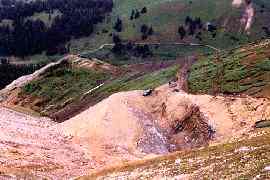 |
 |
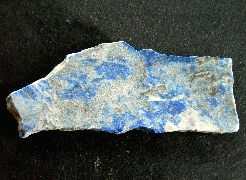 |
| 間歇的に採掘が行われるラピスラズリ鉱山 Italian Mountain, Colorado、U.S.A. |
コロラド産のラピスラズリ 左 4.6cm Lapis-lazuli from Colorado Blue Wrinkle mine, Colorado, U.S.A. |
カリフォルニアのラピスラズリ 94x40x6mm Big Horn Mine, Cascade Canyon San Gabriel Mts., California, U.S.A. |
1939年、コロラド州デンバーの南西170kmのイタリア山地にラピスラズリが発見されました。
1959年から40年間に間歇的に行われた採掘によって得られた量は2〜3トンに過ぎず、しかも宝石細工に適した品質のものは5%に過ぎないとのことですから、市場で見かける機会は滅多にないことでしょう。
1979年にロサンゼルスの北部のサンガブリエル山地の標高3000mの地点に大理石脈中に黄鉄鉱に富むラピスラズリの層が発見されました。
Big Horn Mine と名づけられた鉱床はアフガニスタン産の最上級品に匹敵する高品質とされていますが、この一帯は市の水源地で一般の立ち入り禁止地域のため商業的な採掘が行われることはないようです。
隣接するサンベルナルディーノ郡にやはり1938年にラピスラズリが発見されましたが、鉱脈は数mmとごく小さな規模で、鉱物学的な発見にとどまります。
In 1939, a small lapis-lazuli deposit was discovered in Italian Mtn., 170km south-west of Denver, Colorado, U.S.A.
The production during 1959-1998 by sporadicv mining is estimated 2 to 3 tonnes, of which lapidary quality is only 5%
In 1979, at an altitude of 3000m of San Gabriel Mtns., north of Los Angeles, lapis-lazuli deposits was discovered in pyrite rich marble vein and was named "Big Horn Mine". The quality is said to be equivalent to best Afghan one. However, commercial mining is not possible because of strict environmental control. In neiboughring San Bernadino County, lapis-lazuli deposits was discovered in 1938, too. But the original ore beds are only a few millimeters wide and is of mineralogical interest.
カナダのラピスラズリ(Canadian lapis-lazuli)
lapis-lazuli from Baffin Islands, Canada
left : collected in 1972 right : collected in 1975
at Co-Op claim, 19km north of Lake Harbour Village
photo courtsey of Mr.SPS
カナダのバフィン島にあるハーバー湖付近にも大理石脈中にレンズ状の脈を成すラピスラズリ鉱床があることは古くから原住民のエスキモーニには知られていました。
1971年ごろからは工芸品用に密かに採掘が行われているとのことです。
写真は驚異的なラピスラズリの標本のコレクションと情報をお持ちの"鉱物たちの庭”のspsさんのご好意で使用させていただきました
In Canada, near Harbour Lake of Baffin Island、lapis-lazuli veins has been discovered since long time by local Eskimot people and since 1971, they have been recovering lapis-lazuli disscretly for carving purpose.
チリのラピスラズリ (Chilean lapis-lazuli)
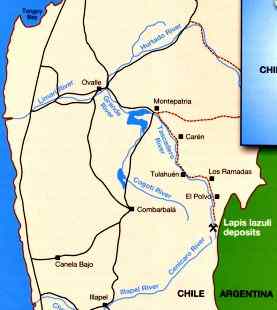 |
 |
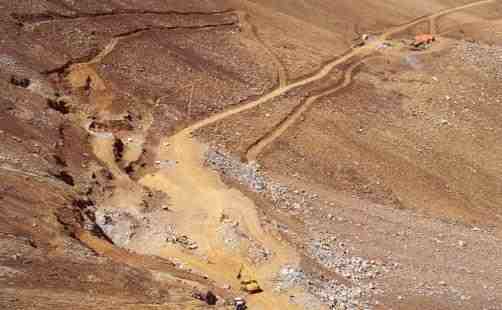 |
 |
| チリのアンデス山中のラピスラズリ鉱山の地図 Lapis-lazuli mine of Chile in Andes Mountains |
露天掘りによる採掘光景 Open-cut mining of lapis-lazuli |
ラピスラズリ鉱脈(Vein) Photo Courtesy : Natsuyo Ishinoda | |
アルゼンチンと国境を接するチリのアンデス山脈の標高3500mの地点にラピスラズリが発見されたのは公式には1850年のことです。中南米各地の紀元前からの遺跡で発掘された装飾品等に青い石が使われていて、それらがチリ産のラピスラズリであるといわれてきましたが、現在ではその大半がボリビアやペルー産のソーダライトであることが判明しています。しかし鉱山に近いプレ・コロンビア文明等の遺跡からはラピスラズリ製の鏃等が発掘されています。したがってラピスラズリが紀元前から原住民によって発見され、使われていた可能性は考えられます。
この鉱山の近代的な採掘が開始されたのは1905年からです。1905年から1910年の間に10トンほどのラピスラズリがドイツに送られました。 当時の輸送手段はロバしかなく、それぞれ100kgの荷を積んだロバが鉱山からセレナの港までの200km余りの道程を2日間で運んだとのことです。かなりの強行軍でした。その後は少量の高品質のラピスラズリがもっぱら国内用に採掘されていました。
1989年に鉱山までの自動車道が完成するまでは毎年の産出量は20〜30トン程でした。
現在では3社の操業で年間150トンのラピスラズリが産出されています。これは世界の生産量の90%以上を占める量ですが、後述するように全てが宝石質ではありません。宝石用以外の等級品は室内装飾用の建築資材として出荷されています。
この鉱床の埋蔵量については現時点で1万トンを超える鉱床が確認されていますが、採掘中の鉱床の北方へ5kmと南に2kmにまで鉱脈の広がりが確認されているため、6万トン或いはさらに大きな量の鉱床が存在すると予想されています。
The first reference of Chilean lapis-lazuli dates back to 1850 . The deposits is located in the Andes Mountains at an elevation of 3500m. In South America, there have been several recent references to the use of chilean lapis-lazuli by the Moche(800-100BC) and Inca (1100 -1537AD) cultures in Peru, Ecuador, Bolivia, Chile and Argentina. However, pre-Columbian artifacts of blue stones from world museums have been studied to reveal that they are sodalite and other blue minerals and not lapis-lazuli. Most of sodalites are believed to have come from Peru or Bolivia.
It is possible, some archeological articles discovered very close to Chilean lapis-lazuli mine might have been mined by early inhabitants in the region.
Modern mining of Chilean lapis-lazuli started since 1905. Between 1905 and 1910, about 10 tonnes of lapis-lazuli from the Coquimbo region were sent to Germany. Later, small, hand-selected pieces of high quality lapis-lazuli were mined and used to supply the local market. Transport at that time was only possible by mule, the journey about 200km from mine to La Serena took two days, and each mule carried 100kg. Until 1989, when the company constructed and access road navigable by truck, only about 20-30 tonnes of lapis-lazuli were being removed annually.
Current production is about 150 tonnes a year of mixed grade material.
Regarding mine reserves, more tha 10,000 tonnes of reserves is proved. In addition, traces of lapis-lazuli 5.5km north and 2km south to the present workings in the same geologic formation were discovered. Hence more than 60,000 tonnes of probable reserved is estimated.
鉱山の現況 (Location and Access to the mine )
鉱山はアンデス山脈のアルゼンチン側と分水嶺を成す国境から500m余りの標高3500mの急峻な斜面にあります。
コキンボ地方の州都からオバーリェの町までは舗装道路で、その先鉱山までの100kmの道程は舗装道路ではありませんが4輪駆動のトラックで辿り着けます。
このため重機による採掘やトラックでの資材や鉱石の輸送が可能となり、年間150トンもの産出を可能にしています。
ただし冬(5月〜9月)の4mもの積雪期間と雪解け時の洪水と道路の補修(10月〜1月)のために、採掘が可能なのは1月半ば〜4月までの期間に限られます。
鉱山は直線に600mほどの間の数ヶ所の露天掘り鉱床で3社が採掘をしています。
The deposit is situated on the steep slopes of glacial cirque, approximately 500m from the Andean watershed that defines the international border between Chile and Argentina. Access to the mining area from the regional center of La Serena is via paved road to Ovalle. and then by dirt road with four-wheel-drive dirt track, which enables the recovery of lapis-lazuli using heavy machine and transportation of annual production of 150 tonnes of ores. The deposit is accesible only during summer time, from January to April. From May to September, the roads and workings are covered with up to 4m of snow; and from October to December, the road is flooded by melt water. Typically much of January is spent repairing road and removing ice from the mining pits. The deposit is mined in a linear array of small pits over a distance of about 600m, covered by three mining concessions.
鉱床の成因(Geology and Occurence)
チリのラピスラズリは2段階の地殻変動作用によって生成され、その過程が下の写真の地形にはっきりと残されて見えるという点で興味深いものです。
最初、およそ2400万年昔に花崗岩の貫入による接触変成で生成された不純な石灰岩層が出来て、さらに1000万年〜1100万年昔に新たに起こった硫黄を含む熱水の貫入による交代作用でラズライト(青金石)が形成されたと考えられています。
このような2段階の変成作用でのラピスラズリの生成はコロラド州のイタリア山の場合も同様の成因であったと考えられます。
一方、アフガニスタンのサーレサン、カナダのバフィン島とシベリアのバイカル湖周辺のラピスラズリは、おそらく堆積岩である頁岩や苦灰岩化した蒸発岩が広域接触変成作用を受けて出来たと考えられます。
Chilean lapis-lazuli formed through the metasomatic introduction of sulfer into impure limestone that was previously metamorphosed by granitic intrusives. Its origin is probably similar to that of Italian Mountain, Colorado. In contrast, the lapis-lazuli deposits at Sar-e-Sang, Baffin Island, and Lake Baikal probably formed during regional metamorphism of shale and dolomitic evaporite deposigts.
左の写真はチリのラピスラズリ鉱山とその成因を現す周囲の地形です。
右端の山の頂のリオ・ラス・クエバス花崗岩層が2400万年前に左の山の頂上付近に露出している中生代のリオ・タスカデロ石灰岩層に貫入した時の接触変成作用で三層の岩石層を形成しました。
写真中央上部の暗く見える部分が花崗岩層に最も近い内側に出来た幅40〜50mの輝石、斜長石、石英と磁鉄鉱を含むホルンフェルスと,灰鉄−灰礬柘榴石を含む幅80〜100mの2番目のスカルン層です。 その下部、2段目の点線が最外周層の幅300mに及ぶ珪灰石ー大理石に変質した石灰岩層です。
およそ1000万年〜1100万年昔に新たに貫入した硫黄分に富む熱水液による交代作用でこの石灰岩中にラピスラズリが最長2m,10cm〜40cm幅の不規則なレンズ状の層を成して形成されました。
写真の矢印はラピスラズリを採掘した残りの母岩のズリの堆積層です。
こうした地形はかつては覆われて見えなかった筈ですが、氷河による侵食でカールとなって内部の層が姿を現したものです。
The geology is well exposed in the steep of the glacial cirque that hosts the lapis-lazuli deposits. Two of the three contact-metamorphic zones adjacent to the granite are distinguishable. The innermost horfels zone and the second skarn zone form a dark band, with an irregular contact against the gray -colored granite. The outer zone is a "cream"-colored wollastnite marble displaying a sharp, straight contact with the second zone. The marble hosts local lenses of lapis-lazuli exposed by a linear array of mining cuts with blue tinged dumps(arrows), barely visible near the top of the scree slopes. The contact between the outermost marble zone and the limestone is obscured by scree.
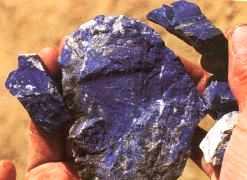 |
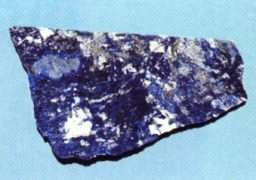 |
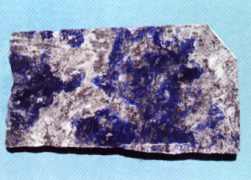 |
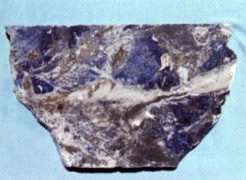 |
| 1級品 first grade sample |
2級品 19x11cm second grade sample |
3級品 18x9cm third grade sample |
4級品 21x13cm fourth grade sample |
チリ産ラピスラズリは一般にやや沈んだ青い色合いで最上級のアフガニスタン産と比べるとウルトラマリンの輝かしい色合いに欠け、さらに大理石の白い斑点を多く含むため市場で余り高い評価が得られません。
しかし冒頭の写真の宝飾品のように最上級のものは使い方次第では魅力的な作品となります。
産地では原石に含まれる青金石の割合と主に珪灰石ー大理石の白い斑点との比率とで1級品から4級品までの等級分けをしています。
青金石が占める割合が70%以上の高いものが宝飾品や工芸品に用いられ70−50%のものは普及品の工芸品用途に、50%以下のものは建築用の内装材に用いられています。
Chilean lapis-lazuli is considered in general inferior to Afghan one, from point of lack of brilliant ultramarine color and excess of white patches of wollastonite-marble. However, as shown on top photo, the best chilean lapis-lazuli is attactive enough when properly designed and finished. In the mine, ores are graded upon percentage of blue lazurite parts with combination of white patches. Stone with more than 70% of lazurite is used for jewelry and carving and 70-50% stone is acceptable for carving in some markets. Material with less than 50% lazurite is used only for construction materials, such as slabs, countertops or tiles.